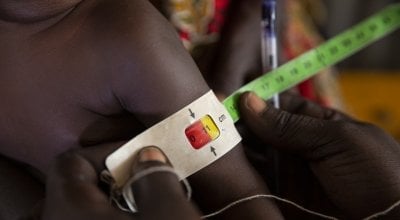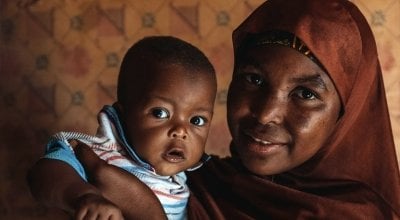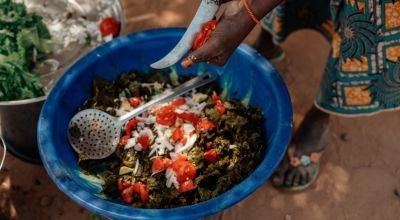
Read our 2023 annual report

Knowledge Hub
Hunger hits children the hardest: As of 2022, 149 million children suffer from stunting, and 45 million from wasting. The side effects of childhood malnutrition can have a lifetime effect. But there is hope.
The first two years of a child’s life are crucial for growth and development. According to the World Health Organisation, well-nourished children are 33% more likely to escape poverty as adults. On the other hand, childhood malnutrition can lead to a lifetime of consequences, including lower IQs, poor socio-emotional skills, and weaker immune systems.
But even for children who suffer from hunger due to drought, conflict, or more, there’s a simple-yet-effective solution that has saved millions of lives over the last two decades.
What is RUTF?
RUTF (ready-to-use therapeutic food) gives malnourished children the vital nutrients they need to recover. The original and most well-known RUTF, Plumpy’nut, was invented in 1996 by French paediatrician André Briend.
As the name suggests, Plumpy’nut is a peanut-based paste served in a foil pouch. This means that it’s portable, non-perishable, and can be eaten by babies who aren’t yet ready for solid foods. (One of Briend’s inspirations came straight from his breakfast table: a jar of Nutella.)

The exact ingredients for an RUTF can vary based on the brand, but the standard RUTF has the same features: high in calories, nutrients, and vitamins to help children suffering from acute malnutrition rapidly gain weight.
RUTF’s history goes hand-in-hand with Concern’s own history. This wasn’t just an invention: It was a revolution in how we treat malnutrition.
A revolution in healthcare
During the hunger crises of the 1980s and 1990s, children with severe acute malnutrition required round-the-clock care at therapeutic feeding centres (TFCs). The nutrients were delivered through therapeutic milk, which required on-site preparation and clean water. Because of the need for 24-hour medical staffing, TFCs were few and far between. They were also often too far from the communities they were meant to serve. Mothers would often need to leave their homes for weeks at a time, which meant lost work and wages (and leaving behind other children).
Recovery rates were low because mums would withdraw their children before they received full treatment so they could return home to work. Infection was also a risk in the crowded patient wards. Millions of children unnecessarily died because they were too far away, relapsed after an incomplete course of treatment, or were exposed to other illnesses.
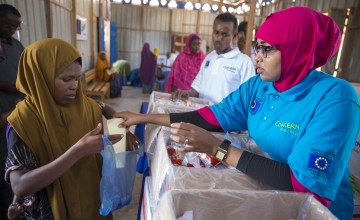
Therapeutic feeding centres could also be dangerous. In a country like Sudan, which balanced famine with conflict, setting up centres to care for the malnourished would open civilians and aid workers up to aerial and ground attacks. While working in Sudan, Concern International Programme Director Anne O’Mahony sensed a breaking point: “More and more, it became clear that centre-based care wasn’t the solution.”
Dr. Briend was aware of this challenge, as well as the medical science that goes into treating malnourished children. The goal became to find a solution that could be administered at home. As he explains:
My hope when I was developing this product was to start a revolution in the management of severe acute malnutrition.
The missing ingredient
Community-based care seemed to be the solution. But there was one more problem: At the time, there wasn’t a suitable food that could be used at home by mothers versus in a clinic by a healthcare professional. Everything required water. If the family used contaminated water, they risked further harming their child.
This is why most therapeutic foods are made with peanuts: First, the crop is generally accessible in the countries with the highest severe malnutrition rates. What’s more, by creating an oil-based product with the nut, there is no room for bacteria to breed. This also meant a long shelf-life and no cooking required. The oil base also helps Plumpy’nut to clock in at 500 much-needed calories per packet.
But developing the food was not enough: We also needed a programme that adapted to this new feeding model. Enter Dr. Steve Collins, whom Briend describes as “the key person to change the approach.”
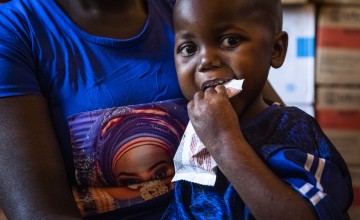
Introducing community-based therapeutic care
Since one of the goals with therapeutic foods was to allow mothers to feed their children at home, this meant decentralising the therapeutic feeding centre model — the same model that Anne O’Mahony said was clearly not the solution.
The new approach to treating malnutrition to go with RUTF was called community-based therapeutic care, or CTC. Its aim was to bring care as close as possible to communities in need. For those children who weren’t experiencing any medical complications from malnutrition, like diarrhoea or anaemia, they could be treated in their own homes. But it was still an unproven method, and so it was slow to catch on.
That changed when Concern Worldwide partnered with Collins’ humanitarian research organisation, Valid. In 2000, famine swept through the Horn of Africa, threatening millions of people in Ethiopia. The government had banned TFCs as they believed them to be ineffective. So Concern and Valid set up a pilot programme for CTCs, called Community-Based Management of Acute Malnutrition.
CMAM and RUTF: A “mind-blowing” duo
Enough people were questioning the effectiveness of the traditional treatments for malnutrition to enable Community-based management of acute malnutrition (CMAM) to be tested in one region of Ethiopia.
Community members were trained to recognise the signs of malnutrition using tools like MUAC tape (which uses the measurement of a child’s arm as a correlation for malnutrition). They were also trained in how to administer Plumpy’nut in children’s homes. Children were monitored through home visits by these trained health workers. Concern and Valid set up extra monitoring to produce concrete data over the course of 9 months.
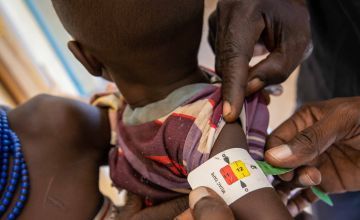
Together, CMAM and RUTF proved to be a powerful duo. In emergencies such as famine, the normal level of child mortality rates is often 20 to 30%. With the combined use of CMAM and RUTF, mortality rates were 4.5%. For a crisis like a famine, that meant an incredible number of lives saved.
“The idea of CTC was sending these children home with the correct food and the care that went with it, so that the mothers could actually take care of them themselves,” Anne O’Mahony notes. “This was a mind-blowing idea in some ways.”
During famines, the standard goal for child mortality rates is 10%. The norm is often 20 to 30%. With the combined use of CMAM and RUTF in Ethiopia, mortality rates were 4.5%.
Further success for RUTF
With one successful pilot on the books, Concern followed up with a larger programme one year later in Darfur, Sudan. We treated 25,000 acutely malnourished children and recorded similarly positive results.
From 2002 until 2006, Concern Worldwide used CMAM and RUTF again in its first large-scale pilot in Malawi. The programme yielded excellent outcomes in treatment, coverage, community acceptance, and cost-effectiveness.
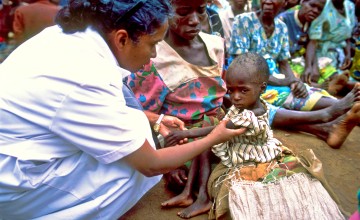
In 2006, Concern and Valid published the CTC field manual. In 2007, the World Health Organisation, UNICEF, and the World Food Programme issued a joint statement recognising CTC as a best practice, setting into motion a transformative approach that is now the global standard.
With just small packets of peanut paste, millions of acutely-malnourished children have been successfully treated through the CMAM approach by Concern Worldwide and others.
Along with other RUTF products, Concern continues to use Plumpy’nut to this day and operates CMAM programmes in nine countries. Worldwide, CMAM reaches more than 70% of malnourished children in over 70 countries.


